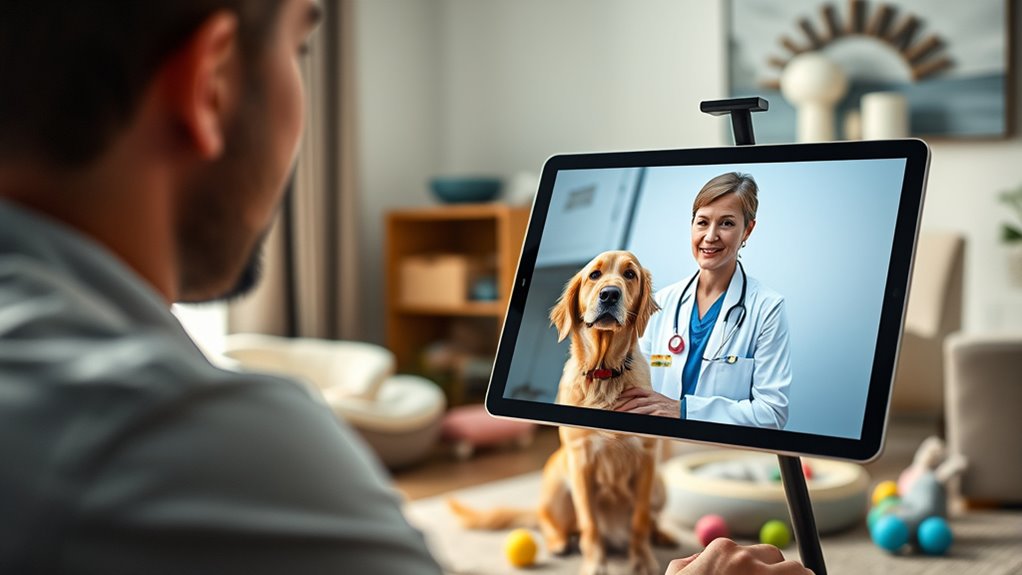Telemedicine for pets uses technology to connect you with vets remotely through video calls, digital images, and wearable health devices. It lets you get advice for minor health issues, follow-up care, and ongoing monitoring without leaving home. While it’s convenient and reduces stress for your pet, it’s not suitable for emergencies. If you want to learn how these innovations can keep your pet healthy, keep exploring the options available.
Key Takeaways
- Telemedicine allows pet owners to consult veterinarians remotely via video calls and digital tools.
- Digital images, wearable devices, and remote monitoring enhance diagnosis and ongoing health tracking.
- It offers convenient, stress-free access for minor issues, follow-ups, and medication management.
- Technology like digital stethoscopes and high-resolution cameras improve remote diagnostic accuracy.
- In-person visits remain essential for emergencies and serious health concerns beyond virtual care capabilities.

Have you ever wondered how technology is transforming pet care? Telemedicine for pets is revolutionizing how pet owners access veterinary services, making expert advice more convenient than ever. As a pet owner, you’re likely seeking ways to guarantee your furry friend receives timely, quality care without the stress of travel or waiting rooms. Telemedicine offers a practical solution, but it also requires some pet owner tips to maximize its benefits. One of the key aspects is understanding how veterinary technology is evolving to support remote consultations. With high-quality video calls, digital images, and even wearable health devices, veterinarians can assess your pet’s condition effectively from a distance. These advancements mean you can get professional guidance on minor issues or follow-up care without a trip to the clinic.
When it comes to pet owner tips, it’s imperative to prepare for virtual vet visits just as you would for in-person appointments. Keep your pet’s medical history nearby, including vaccination records and any recent symptoms you’ve observed. Make sure your device has a stable internet connection, and choose a quiet, well-lit space where your pet feels comfortable. This setting allows the veterinarian to get a clear view and better evaluate your pet’s condition. During the consultation, be honest and detailed about your pet’s behaviors, eating habits, and any changes you’ve noticed. This information helps the vet make an accurate assessment, even through a screen. Remember, telemedicine isn’t suitable for emergencies; knowing when to seek immediate, in-person care is essential. Use virtual visits for minor concerns, medication refills, or follow-up questions, but never hesitate to go to the nearest emergency vet if your pet’s condition worsens suddenly. Additionally, understanding the role of AI in healthcare can help pet owners appreciate the rapid advancements in remote diagnostics and treatment options.
Veterinary technology plays a significant role in making telemedicine feasible and effective. Digital stethoscopes, high-resolution cameras, and remote monitoring tools enable veterinarians to gather important data remotely. Some pet owner tips also include utilizing wearable devices that track activity levels, heart rate, or sleep patterns, providing additional insights into your pet’s health. As technology advances, more pet-specific gadgets will become available, allowing for continuous health monitoring. This can lead to early detection of issues and prompt intervention, ultimately saving your pet from discomfort or serious health problems. Embracing telemedicine means staying informed about these innovations and integrating them into your pet care routine. With the right approach, telehealth can complement traditional veterinary visits, offering a thorough, accessible way to keep your pet healthy and happy.
Frequently Asked Questions
Can Telemedicine Replace In-Person Vet Visits Entirely?
Telemedicine can’t fully replace in-person vet visits because of technology limitations and emergency care considerations. While virtual care helps with minor issues and follow-ups, it often falls short for urgent or complex cases that need hands-on exams or treatments. You should still seek in-person care when your pet shows severe symptoms or if the situation requires immediate attention, as virtual visits can’t always provide the all-encompassing care your pet needs.
What Types of Pet Health Issues Are Suitable for Virtual Consultations?
You can use virtual consultations for various pet health issues, including routine checkups and behavior concerns. If your pet shows signs of minor illnesses, skin issues, or needs dietary advice, a virtual visit can be helpful. However, for emergencies or symptoms requiring physical exams or diagnostics, in-person care is essential. Always assess whether the issue is suitable for remote advice or needs immediate veterinary attention.
How Do I Prepare My Pet for a Telemedicine Appointment?
You prep your pet for a telemedicine appointment by gathering recent pet behavior notes and medication details. Keep your pet calm and comfortable, perhaps with a favorite toy or treat, to guarantee they stay still during the call. Have their medical records handy and note any changes in behavior or symptoms. This way, the vet gets clear info to assist with medication management and accurately assess your pet’s health.
Are Telemedicine Vet Services Covered by Pet Insurance?
Most pet insurance plans now include coverage for telemedicine vet services, but it varies. You should check your insurance policy for specific coverage details, including reimbursement policies. Some insurers cover telehealth consultations fully, while others may require you to pay upfront and seek reimbursement. Contact your provider to confirm if telemedicine visits are covered and understand any limitations or requirements to make sure you’re prepared for your pet’s virtual care.
How Secure Is My Pet’s Medical Information During Virtual Visits?
Your pet’s medical information stays secure during virtual visits thanks to strict data privacy measures and advanced security protocols. Reputable telemedicine platforms use encryption and secure servers to protect your data, ensuring unauthorized access is prevented. As a pet owner, you can feel confident that your pet’s health details are handled with care and confidentiality, just like in traditional vet visits. Always verify that the platform follows industry standards for data security.
Conclusion
Imagine your pet cozy at home, their favorite blanket wrapped around them, as you gently hold your phone. With a few taps, you’re connected to a caring vet, ready to ease their discomfort or answer your questions. Telemedicine transforms worry into comfort, turning your screen into a window of hope. So, next time your furry friend needs help, remember—help is just a click away, bringing peace right to your living room.









